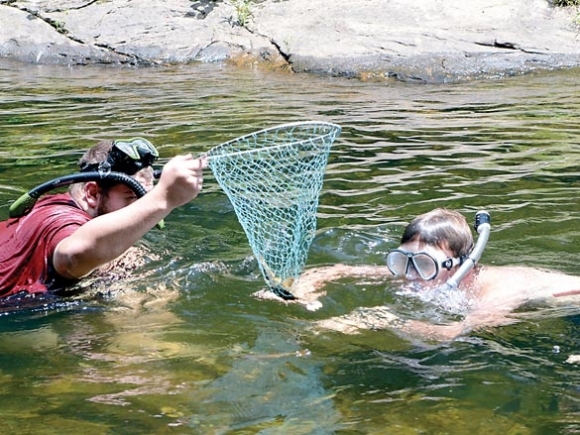Under the Pigeon: Snorkeling workshop gives an up-close look at aquatic diversity

The clear water of the West Fork Pigeon River tumbling from its mountain headwaters takes on a yellowish hue through the plastic of the snorkel mask, revealing a riverbed of rounded rocks that sometimes sit within inches of the surface and sometimes plunge feet below.
Fish swim placidly in the flow, darting only occasionally when the wearer of the snorkel mask draws a bit too close for comfort. Here and there a leaf or a stick streams by like a stowaway for parts unknown.
The water eventually finds its way into the snorkel mask, forcing a temporary retreat from the underwater world. Above the surface, it’s a sunny July day near Haywood County’s Jukebox Junction, and the river is full of people — ages ranging from the young to the not-so-young — dipping in and out to see the freshwater ecosystem in a way that few of them ever had before.
 “It’s like a tropical reef when you snorkel,” said Shannon Rabby, lead instructor of Haywood Community College’s Fish and Wildlife Management Technology Department. “Most people don’t know that. They stand on the banks and they look in the water and they don’t see a lot of fish. Take a snorkel on a hot summer day like this, stick your head under the water, and it’s amazing all the fish that are there — beautiful fish.”
“It’s like a tropical reef when you snorkel,” said Shannon Rabby, lead instructor of Haywood Community College’s Fish and Wildlife Management Technology Department. “Most people don’t know that. They stand on the banks and they look in the water and they don’t see a lot of fish. Take a snorkel on a hot summer day like this, stick your head under the water, and it’s amazing all the fish that are there — beautiful fish.”
Rabby and his aquatic ecology students were leading the day’s events, which drew 21 guests, in conjunction with the Haywood Waterways Association. It’s an annual workshop the organizations have collaborated on for the past three years and part of an ongoing series that Haywood Waterways has hosted since 2014, called “Get to Know Your Watershed.” The hikes, paddle trips and other events included in the series offer locals a chance to see firsthand the beauty that Haywood’s high-quality waterways foster, in the company of experts who can help them leave with a better understanding of how it all connects.
“We often work on the degraded streams, the bad streams, so it’s nice to raise awareness for all the nice areas in Haywood County,” said Haywood Waterways Director Eric Romaniszyn. “It’s easier to protect a stream from being degraded than it is to improve a stream after it’s been degraded.”
Related Items
The West Fork Pigeon River definitely qualifies as a “nice” stream. It’s always gotten an A grade for water quality, Romaniszyn said — and really, A-plus would be a better descriptor.
“Talk to anyone who trout fishes, and it’s one of the best streams not only to catch a lot of trout, but big trout,” he said.
That’s because the river tumbles straight from its source in the Pisgah National Forest and has passed only 100 to 200 homes by the time it reaches Jukebox Junction. There’s been little opportunity for pollution, and the still-cold water keeps it friendly for trout.
Just downriver from the snorkelers, another group was getting a first-hand look at the abundance of aquatic life in the water.
“If all goes as planned, we’ll have a lot of fish in here,” one of the HCC students holding the sides of a large net told the group.
The net, called a seine, was long and rectangular with bamboo poles sewn to two of its sides. The students held the stretched-out net vertically in the water, its edge as close to the river bottom as possible, and instructed the participants to form a line across the water upstream. Then, the group walked forward in unison, splashing and kicking at the rocks with all their might on their way to the net.
 That was the cue to raise the net out of the water and see what it had snared — at first sight, nothing. At second sight, a single hellgrammite, a long and armored larva that would one day turn into a Dobson fly.
That was the cue to raise the net out of the water and see what it had snared — at first sight, nothing. At second sight, a single hellgrammite, a long and armored larva that would one day turn into a Dobson fly.
So, the net crew tried again, shifting over to slightly faster-moving water. The line formed, the splashing began, the net lifted — and this time, there were at least five thrashing, shining fish in view. Each beautiful, each different, and each identifiable to the HCC students leading the exercise.
“We can go out in the stream and catch crawdads by ourselves, but they (the students) could tell us every species that we saw, and that’s a whole other level of fun and enjoyment for our kids,” said Susan Roberts, who attended with her husband and three young children.
After instructing the participants to make sure their hands were good and wet before touching the fish, the HCC students gave the go-ahead to pick them up, look them over, and get help identifying them.
The smaller residents of the West Fork didn’t get overlooked, either. A third group, the “bugging crew” took to the water with nets and buckets to search for benthic macroinvertebrates — a fancy name for aquatic bugs. Many of these bugs are, in fact, larvae, creatures that will one day transform into dragonflies or caddis flies or any of a number of other insects.
“I didn’t realize there were so many species of macroinvertebrates and fish,” said Lindsey Meyers, 24, of Waynesville. “I didn’t know any of them before I started. I just moved here so it was a wonderful introduction to the ecosystem here.”
For Romaniszyn, the West Fork Pigeon will always be a special place, because that’s where he once found himself face-to-face with a hellbender. The giant salamanders average 12-15 inches in length and spend most of the day underneath river rocks, emerging at night to hunt. Requiring clean water to survive, hellbender populations have been declining in recent decades — between those decreasing numbers and their secretive nature, it’s rare to see one in the wild.
“They like the big rocks with spaces underneath that they can crawl under,” Romaniszyn said as he recalled the excursion with the N.C. Wildlife Resources Commission when he saw his hellbender. “I stuck my head under the opening, didn’t see one but then I went slowly over the rock and looked under the crevice from above.”
There it was, looking back at him. The moment stayed suspended until Romaniszyn reached out to pick the creature up. The hellbender disappeared.
“They’re amazingly fast. They’re like a fish almost,” he said.
Under the free-flowing waters of the West Fork, you never know what you might find.









